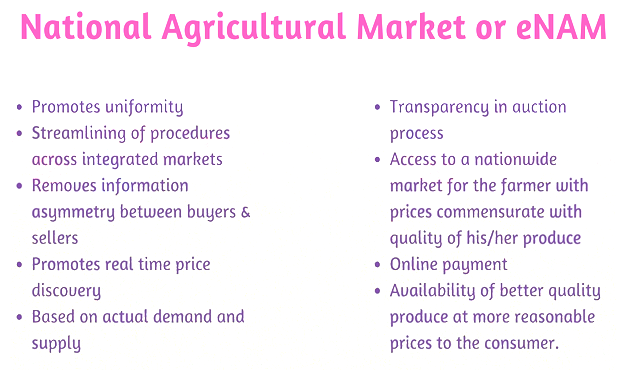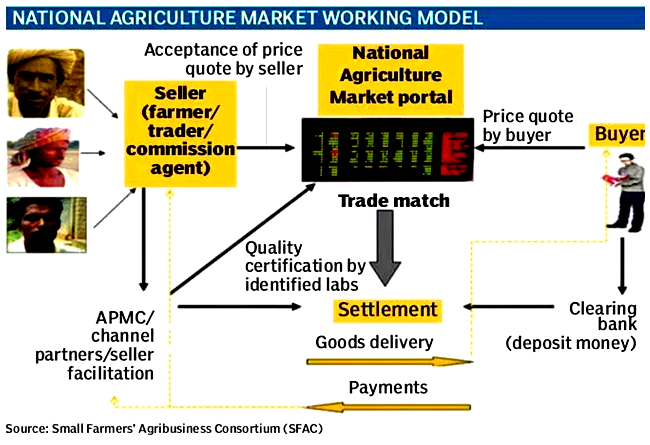New Features Added To E-NAM
- 03 Apr 2020
- On 2nd April, 2020, the Centre launched new features on the electronic national agriculture market (e-NAM) platform to make it more convenient for farmers to sell their produce at warehouses and collection centres set up by farmer producer organisations (FPOs).
Need
- The features have been launched at the time when there is a critical need to decongest mandis to effectively fight against COVID-19.
- To strengthen agriculture marketing by farmers across the country.
New Features
Electronic-Negotiable Warehouse Receipt (e-NWRs) Module
- Warehouse (Registered with WDRA) trading module with payment feature is to enable small & marginal famers to directly trade their stored produce from selected WDRA registered warehouses which are declared deemed market by the State.
- Farmers will be able to place their produce in WDRA accredited warehouses.
Benefits of eNWRs integration with e-NAM
- Depositor can save the Logistics expenses and will have better income.
- Farmers can sell the produce across the Nation to get better Price and at the same time can save himself from hassle of mandi.
- Farmers will be able to place their produce in WDRA accredited warehouses avail the benefit of pledge loan if required.
- Price stabilization by matching supply and demand through time and place utility.
Farmers Producer Organisation (FPO) Trading Module
- FPO trading module will help to enable FPOs to upload their produce from their premise/ collection centres for bidding.
- FPOs have the option for delivery of produce either from their premises or by bringing to mandi premise after successful bidding.
- Facility provided to FPO to upload assaying report / photo of their produce from their premise to enable traders to visualise the produce before bidding.
Benefits of FPO trading module
- This will not only decongest the mandis but also reduce the hassle of FPOs to deal with mandis.
- This will help FPOs by reducing transaction costs (Transportation) and enhancing their bargaining power.
- Facilitates FPOs to avail online payment facility with ease of doing business.
Logistic Module
- As s a quantum response to logistic need by traders, provision has been made for linking large logistic aggregator platforms, which will provide choices to users.
- Traders would be able to use the link to navigate to the logistics provider’s website and select appropriate services.
Benefits of Logistic Module
- Will help in seamless transportation of agri produce.
- Will promote inter-State trade under e-NAM by providing online transport facilities for distant buyers.
National Agriculture Market (eNAM)
- Launched in 2016, eNAM is a pan-India electronic trading portal which networks the existing APMC mandis to create a unified national market for agricultural commodities.
- Small Farmers Agribusiness Consortium (SFAC) is the lead agency for implementing eNAM under the aegis of Ministry of Agriculture and Farmer’s Welfare.
- SFAC through open tender selected Nagarjuna Fertilizers and Chemicals Ltd / Ikisan Division as Strategic Partner (SP) to develop, operate and maintain the NAM e-platform.
Vision
- To promote uniformity in agriculture marketing by streamlining of procedures across the integrated markets.
- Removing information asymmetry between buyers and sellers and promoting real time price discovery based on actual demand and supply.

Salient Features
- It allows states to have their own agri-marketing platforms that can be linked with NAM.
- The highlight of the scheme is the single point levy of market fees, i.e. on the first wholesale purchase from the farmer.
- The provision lets farmers to showcase their produce in nearby markets and facilitate traders from anywhere to quote price.
- Under the scheme, a provision of Soil Testing Laboratories in or near the selected mandi (market) has been set up. This will help visiting farmers access the facility in the mandi itself.

Benefits
Farmers
- They can sell products without the interference of any brokers or middlemen thereby making competitive returns out of their investment.
Traders
- Traders will be able to do secondary trading from one APMC to another one anywhere in India.
- Local traders can get access to the larger national market for secondary trading.
Buyers, Processers & Exporters
- Buyers like large retailers, processors or exporters will be able to source commodities from any mandi in India thereby reducing the inter-mediation cost.
- Their physical presence and dependence on intermediaries will not be needed.
Consumers
- NAM will increase the number of traders and the competition among them increases. This translates into stable prices and availability to the consumers.
Mandis
- There will be a reduction in bookkeeping and reporting system as it will be generated automatically.
- Monitoring and regulation of traders and commission agents become easy.
- Transparency in the process eliminates the scope of manipulation of tendering/auctioning process.
- Market allocation fee will increase due to an accounting of all transactions taking place in the market.
- It will reduce the manpower requirements as the tendering/auctioning process is carried out electronically.
Others
- With one license for the entire state and single point levy, an entire state becomes a market and the market fragmentation within the same state gets abolished.
- It will improve the supply chain of commodities and reduces wastages.




